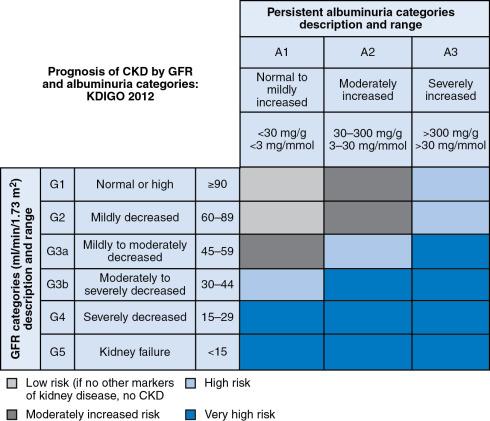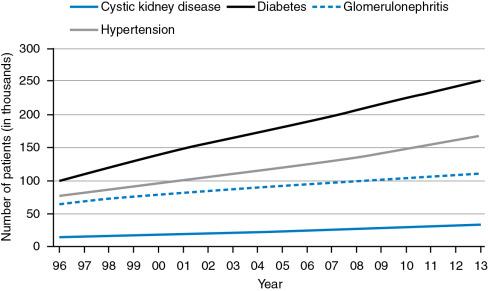Physical Address
304 North Cardinal St.
Dorchester Center, MA 02124
CKD is defined as the presence of kidney damage or decreased kidney function (defined as estimated glomerular filtration rate [eGFR] <60 mL/min per 1.73 m 2 ) for 3 or more months, irrespective of the cause. The persistence for at least 3 months is necessary to distinguish CKD from acute kidney injury (AKI). Markers of kidney damage include:
Albuminuria with albumin to creatinine ratio (ACR) ≥30 mg/g
Urine sediment abnormalities
Electrolyte abnormalities due to tubular disorders
Abnormalities detected by histology
Structural abnormalities detected by imaging
History of kidney transplantation
This definition is derived from the Kidney Disease: Improving Global Outcomes (KDIGO) 2012 Clinical Practice Guideline for the Evaluation and Management of Chronic Kidney Disease. For this definition, eGFR is calculated from serum creatinine using the Chronic Kidney Disease Epidemiology Collaboration (CKD-EPI) equation. Those with eGFR <60 mL/min per 1.73m 2 are considered to have reduced kidney function. Urinary albumin is assessed from the ACR, with four levels of ACR considered: <10 mg/g, 10 to <30 mg/g (normal to slightly elevated), 30 to 300 mg/g (moderately increased), and >300 mg/g (severely increased).
Among patients who are diagnosed using the criteria described previously, staging of CKD should be done according to Table 18.1 and based on:
Cause of disease
Six categories of eGFR (G stages)
Three levels of albuminuria (A stages)
| GFR Stages | egfr (mL/min/1.73m2) | Terms |
|---|---|---|
| G1 | >90 | Normal or high |
| G2 | 60–89 | Mildly decreased |
| G3a | 45–59 | Mildly to moderately decreased |
| G3b | 30–44 | Moderately to severely decreased |
| G4 | 15–29 | Severely decreased |
| G5 | <15 | Kidney failure (add D if treated by dialysis) |
| Albuminuria Stages | Albumin/creatinine ratio (mg/g) | Terms |
| A1 | <30 | Normal to mildly increased |
| A2 | 30–300 | Moderately increased |
| A3 | >300 | Severely increased |
eGFR is used clinically to evaluate the degree of kidney impairment, to follow the course of the disease, and to assess the response to therapy.
Staging patients with CKD according to cause, eGFR, and albuminuria enhances risk stratification for the major complications of CKD. As seen in Fig. 18.1 , increasing albuminuria is associated with a higher risk of adverse events at every level of eGFR. These complications include kidney outcomes and mortality. Risk stratification is used to inform appropriate treatments, determine the intensity of monitoring, and facilitate patient education. In addition, the definition and staging of CKD has been useful in providing a common terminology for CKD to facilitate the study of the epidemiology, natural history, and prognosis of CKD.

The main reasons for identifying CKD at an early stage are:
To make a definitive diagnosis in case there are specific therapies that can be started
To institute treatment to prevent progression of kidney disease such as inhibition of the renin-angiotensin system
To manage the complications of CKD, including anemia, mineral and bone disorders, acidosis, and most importantly cardiovascular disease
To enhance measures to prevent and detect AKI, given CKD is associated with a higher incidence of AKI
To plan for renal replacement therapy, whether it be initiating a transplant evaluation or planning for vascular or peritoneal access for initiation of dialysis
Not recognizing CKD results in patients presenting at or near end-stage, often requiring the emergency initiation of dialysis, which is associated with worse outcomes.
Serum creatinine alone is an imperfect marker of kidney function, since creatinine level can be influenced by such factors as muscle mass, protein intake, and drugs that affect tubular creatinine secretion such as trimethoprim or fenofibrate. The estimating equations have been derived using regression analysis of studies where GFR and serum creatinine have been directly measured, and the equations include a combination of other demographic and clinical variables.
Urinary albumin measurement is the most abundant protein lost in the urine, and its measurement is more standardized than that of urinary total protein. Albuminuria is a risk factor for the development of end-stage kidney disease (ESKD) in the general population, and a powerful predictor of kidney outcomes in CKD patients (see Fig. 18.1), with prognosis being worse with higher levels of albuminuria. Nephrotic range proteinuria (ACR > 2200 mg/g) is associated with even higher risks. Reduction of proteinuria in clinical trials is usually, but not always, associated with improved kidney outcomes.
The normal GFR in young adults is approximately 125 mL/min per 1.73 m 2 . GFR declines with age, with the mean GFR being 65 mL/min per m 2 at ages 80 to 89 years. Other studies have demonstrated a decline in GFR ranging from 6 to 12 mL/min per 1.73 m 2 per decade of age. Increased ACR also occurs with aging. There has been controversy as to whether a decreased eGFR or increased ACR is a disease or part of normal aging. Since these abnormalities are associated with adverse outcomes, these people should be classified as having CKD.
The leading causes of CKD are:
Diabetes
Hypertension
Glomerulonephritis
Cystic kidney disease.
The current prevalence of each of these causes in the U.S. population from 1996 to 2013 is displayed in Fig. 18.2 . As can be seen, diabetes is the most common cause, with almost half of all people with CKD having diabetes. All four of these leading causes have been increasing over time.

Become a Clinical Tree membership for Full access and enjoy Unlimited articles
If you are a member. Log in here